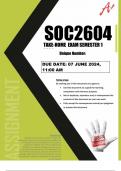Exam (elaborations)
SOC2604 TAKE HOME EXAM Semester 1 2024 (Full referenced solutions)
- Course
- Institution
100% accurate and reliable solutions for SOC2604 Take home exam semester 1 2024: Duration: 05 JUNE 2024, 11:00 to 07 JUNE 2024, 11:00 AM (Take-Home Exam)
[Show more]



